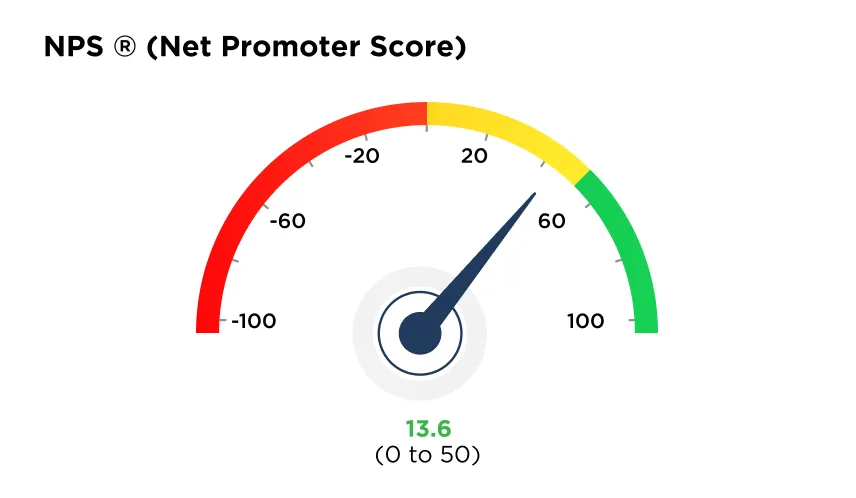Survey response rates can make or break your customer feedback strategy.
The difference between a 15% response rate and a 45% response rate isn’t just about the survey content—timing plays a massive role in whether your customers actually open, read, and complete your surveys.
Getting the timing right means understanding when your audience is most receptive to feedback requests.
With SurveyVista’s native Salesforce integration, you can automate optimal survey timing based on your customer data and behavior patterns. Let’s explore what the research tells us about maximizing survey engagement through strategic timing.
Survey Email Timing
Monday Wins for Both Customer and Internal Surveys
Mondays consistently outperformed every other day of the week for survey responses.
Customer surveys sent on Mondays can see a 10% higher response rate compared to the weekly average. Internal employee surveys performed even better, with Monday sends generating 13% more responses than other weekdays.
The Monday advantage makes psychological sense—people start their week with a cleaner mental slate and often tackle their inbox with fresh energy. This pattern held true across different industries and survey types.
The Friday Problem Every Marketer Should Know
Friday presents the opposite challenge for survey response rates. Friday surveys received 13% fewer responses than the weekly average.
Friday fatigue is real—people are mentally checking out, clearing their inboxes, and preparing for the weekend. Your carefully crafted survey email is more likely to get deleted or ignored when it arrives on a Friday afternoon.
Understanding the Friday problem helps you avoid one of the biggest timing mistakes in survey distribution. Save your important feedback requests for earlier in the week when attention spans are longer and engagement levels are higher.
Best Times of Day to Send Survey Emails
Morning Magic (Before 10 AM)
Early morning sends capture people when their inboxes are manageable and their focus is sharp.
The sweet spot appears to be between 8 AM and 10 AM, when professionals are settling into their workday but haven’t yet been overwhelmed by meetings and urgent tasks.
Desktop users show peak engagement around 10 AM, making this an ideal time for B2B surveys that require more detailed responses.
Morning sends work particularly well for surveys that require thoughtful responses when people’s mental energy is highest.
The Late Afternoon Sweet Spot (3-6 PM)
Late afternoon presents another opportunity window for survey emails.
Between 3 PM and 6 PM, people often experience a natural lull in their workday intensity, making them more receptive to non-urgent requests like surveys.
This timing aligns perfectly with mobile user behavior patterns.
Many people check personal emails and complete quick tasks on their phones during this afternoon window, especially if your survey is mobile-optimized.
Professional work rhythms naturally create this afternoon opening—after the lunch rush but before the final push to finish daily tasks.
When 2 PM, 5 PM, and 8 PM Work Best
Omnisend’s email timing research identified three specific times that consistently drive higher engagement: 2 PM, 5 PM, and 8 PM.
These times align with natural breaks in people’s daily routines and energy cycles.
The 2 PM slot catches the post-lunch period when people are settling back into work mode.
5 PM represents the transition time between work and personal activities when people are winding down professionally but still in a productive mindset.
8 PM works particularly well for consumer-focused surveys when people are relaxing at home with their mobile devices.
This timing requires mobile-optimized surveys since most responses will come from phones or tablets.
B2B vs B2C Survey Timing Strategies
B2B Professional Timing Rules
Business audiences operate on predictable professional schedules, making their optimal survey timing more straightforward.
Weekdays are non-negotiable for B2B survey success—weekends simply don’t work for professional audiences.
Morning sends between 9 AM and 11 AM capture B2B respondents when they’re most focused.
Late afternoon slots from 3 PM to 5 PM offer a second opportunity window before the workday ends.
Avoid lunch hours (12 PM to 1 PM) and typical meeting-heavy times. Strategic timing shows you understand their work patterns and value their expertise.
B2C Consumer Behavior Patterns
Consumer audiences offer more flexibility but require different timing strategies based on survey length and complexity.
Short surveys under 15 minutes perform exceptionally well on Tuesdays when people have settled into their weekly routine.
Longer surveys requiring more time and thought see better success rates on Wednesdays and Fridays.
Wednesday represents the week’s midpoint when people have mental space for deeper engagement.
Weekend opportunities exist for B2C surveys, but only with proper mobile optimization.
Consumer audiences are more likely to complete surveys on their phones during weekend downtime, but the survey experience must be seamless on mobile devices.
Survey Length Impact on Timing
Survey length dramatically affects optimal timing strategies. Quick pulse surveys (under 5 minutes) can succeed almost any time of day because they require minimal commitment from respondents.
Medium-length surveys (5-15 minutes) need more strategic timing to ensure people have adequate time and attention.
These work best during natural break periods like mid-morning, early afternoon, or early evening.
Longer surveys requiring 15+ minutes demand premium timing slots when people have both time and mental energy.
Consider breaking longer surveys into segments if timing becomes challenging.
Mobile vs Desktop Survey Timing Differences
Mobile User Response Patterns
Mobile survey responses spike during late afternoon and evening hours when people are commuting, relaxing, or multitasking on their devices.
The 4 PM to 8 PM window shows consistently strong mobile engagement across different demographics.
Weekend mobile opportunities are real but require surveys designed specifically for small screens and touch interfaces. Saturday and Sunday afternoons work well for consumer surveys when people are browsing their phones during downtime.
Evening mobile engagement often happens in shorter bursts, making this timing ideal for brief pulse surveys rather than lengthy feedback forms.
Desktop User Preferences
Desktop survey engagement peaks during traditional work hours, with 10 AM and 2 PM showing the strongest response patterns.
These times align with when people are actively working at computers and have full attention for survey completion.
Weekday-focused strategies work best for desktop users since most computer-based survey completion happens during professional hours.
Weekend desktop usage drops significantly compared to mobile engagement.
The desktop advantage lies in survey complexity—users can handle longer forms, detailed questions, and multi-step processes more easily on larger screens with full keyboards.
Days to Avoid for Survey Emails
Weekend Challenges and Exceptions
Weekend survey sends generally underperform compared to weekday distribution, but exceptions exist for specific audiences and survey types.
B2C mobile-optimized surveys can succeed on weekends, particularly Saturday afternoons when people have leisure time to engage with brands.
The weekend challenge stems from different mindsets—people aren’t in “business mode” and may not prioritize survey completion.
However, consumer brands with strong emotional connections can sometimes break through weekend noise.
Consider your brand relationship with respondents before attempting weekend sends.
Holiday and Vacation Period Strategy
Major holidays create survey timing dead zones that smart marketers avoid entirely.
Thanksgiving week, Christmas week, and New Year’s week show dramatically reduced response rates across all industries and audience types.
Planning around common vacation periods requires understanding your audience’s seasonal patterns.
Summer vacation weeks affect different demographics differently—families with school-age children versus professionals have distinct availability patterns.
The solution involves building holiday awareness into your survey calendar and planning alternative timing for critical feedback collection periods.
Industry-Specific Timing Considerations
Retail businesses face unique survey timing challenges during busy seasons like Black Friday, back-to-school periods, and holiday shopping rushes.
Customer attention is focused on purchasing decisions rather than feedback completion during these high-intensity periods.
B2B quarterly reporting periods create similar timing obstacles when finance teams, executives, and department heads are consumed with closing books and preparing reports.
Educational organizations must navigate academic calendars, with survey timing affected by semester starts, finals periods, and summer breaks.
Understanding your industry’s natural rhythms helps avoid timing conflicts that reduce survey effectiveness.
How to Test and Optimize Your Survey Timing
Setting Up Timing Tests
A/B testing different send days provides concrete data about your specific audience’s preferences rather than relying solely on general timing research.
Split your survey list randomly and send identical surveys on different days to measure response rate differences.
Time-based split testing requires careful methodology to ensure reliable results.
Test one variable at a time—either day of week or time of day—to isolate what’s actually driving response rate changes.
Document your testing results to build institutional knowledge about your audience’s timing preferences. What works for one customer segment might not work for another.
Measuring What Matters
Response rate metrics tell only part of the timing story—completion rates reveal whether people who start your survey actually finish it.
Some timing strategies might generate more opens but fewer completions due to attention span differences.
Quality of responses varies by timing, with rushed responses during busy periods providing less valuable insights than thoughtful responses during optimal timing windows.
Long-term engagement patterns show whether good timing creates lasting survey participation habits.
Track metrics beyond immediate response rates to understand timing’s full impact on your feedback collection strategy.
Using SurveyVista’s Native Salesforce Integration for Timing Optimization
SurveyVista’s Salesforce integration enables automated optimal send times based on individual customer data and behavior patterns. Instead of guessing about timing, you can leverage actual customer interaction data to determine when each person is most likely to engage.
Customer journey stage-based timing ensures surveys arrive when customers are most receptive to providing feedback. Automated survey reminders within Salesforce workflows eliminate manual timing management while ensuring consistent optimization.
This native integration means your survey timing optimization happens within your existing Salesforce environment without requiring additional platforms or complex connections.
Advanced Survey Timing Strategies
Audience Segmentation for Timing
Customer lifecycle stage creates distinct timing preferences that smart marketers can leverage for better response rates.
New customers often respond quickly to feedback requests, while established customers might prefer less frequent but more strategic timing.
Geographic and demographic timing variations require segmented approaches for national or international survey campaigns.
Behavioral data-driven send time optimization uses past interaction patterns to predict optimal survey timing for individual customers.
The key is moving beyond one-size-fits-all timing toward personalized survey delivery that respects individual customer preferences and behaviors.
Follow-Up Email Timing
Optimal gaps between initial survey sends and reminder emails typically range from 3-5 business days, giving people adequate time to respond without feeling pressured.
Too-frequent follow-ups can damage relationships and reduce future survey participation.
Weekday follow-up strategies work best since reminder emails sent on weekends often get lost in personal email management.
Two reminder emails represent the maximum for most audiences—beyond that, you risk avoiding survey fatigue and annoying people who have consciously chosen not to participate.
Follow-up timing should consider the original send day and time to avoid creating repetitive patterns that customers might start ignoring.
Seasonal Timing Adjustments
Quarterly business cycles affect B2B survey timing significantly, with end-of-quarter periods creating natural obstacles to survey participation.
Planning feedback collection for the beginning or middle of quarters typically yields better results.
Holiday season modifications require advance planning since November and December present unique challenges for survey timing. Summer vacation period adaptations acknowledge that July and August often show reduced response rates due to vacation schedules.
Seasonal adjustments should be built into annual survey planning rather than treated as last-minute timing decisions.
Common Survey Timing Mistakes to Avoid
The “Send It Now” Trap
Immediate survey sending often hurts response rates because it ignores optimal timing principles in favor of convenience.
The urgency to get feedback quickly can backfire when surveys arrive at suboptimal times for your audience.
Planning ahead for optimal timing requires building survey schedules into your marketing calendar and customer journey workflows.
Building timing considerations into survey workflows from the beginning ensures optimal delivery becomes automatic rather than an afterthought.
The best survey timing strategies balance urgency with optimization—sometimes waiting a day or two for better timing dramatically improves results.
Ignoring Your Specific Audience
Generic timing advice provides helpful starting points but can’t replace understanding your specific audience’s behavior patterns and preferences.
Industry research offers guidelines, but your customers might have unique timing preferences that differ from general recommendations.
Survey timing based on survey type often overrides general best practices—what works for retail customers might fail completely for healthcare professionals or educational audiences.
Customer base behavior analysis reveals timing patterns specific to your audience that generic research can’t capture.
The solution involves testing timing strategies with your specific audience rather than assuming general recommendations will work for your unique customer base.
Forgetting About Time Zones
Multi-region survey timing challenges multiply when your audience spans multiple time zones, making single send times suboptimal for significant portions of your list.
Scheduling survey dispatch for specific dates ensures surveys arrive at optimal local times for different geographic segments.
SurveyVista’s Salesforce integration handles time zone management automatically, sending surveys at optimal local times based on customer location data stored in your Salesforce org.
Time zone considerations become even more complex for international audiences, where cultural differences in email habits and work schedules add another layer of timing complexity.
Putting It All Together with SurveyVista
Seamless Timing Integration in Salesforce
SurveyVista’s native Salesforce integration transforms survey timing from a manual guessing game into an automated, data-driven process.
Your customer data directly informs optimal send times without requiring external platforms or complex integrations.
Ready to optimize your survey timing and boost response rates?
Discover how SurveyVista’s 100% Salesforce-native platform can automate optimal survey delivery based on your customer data and behavior patterns.
Frequently Asked Questions
What’s the single best day to send survey emails?
Monday consistently outperforms other days, with 10% higher response rates for customer surveys and 13% higher for employee surveys. People start their week with fresh energy and cleaner mental bandwidth for feedback requests.
Should I avoid sending surveys on Fridays?
Yes, Friday surveys receive 13% fewer responses than the weekly average. People are mentally checking out for the weekend and often mass-delete emails during end-of-week inbox clearing sessions.
What time of day works best for survey emails?
Morning sends between 8-10 AM capture peak attention, while late afternoon (3-6 PM) offers a second opportunity window. Specific high-performing times include 2 PM, 5 PM, and 8 PM depending on your audience.
Do B2B and B2C surveys need different timing strategies?
Absolutely. B2B audiences respond best during weekday business hours (9-11 AM, 3-5 PM), while B2C audiences offer more flexibility including evenings and weekends, especially for mobile-optimized surveys.
How does survey length affect optimal timing?
Short surveys (under 5 minutes) work almost anytime. Medium surveys (5-15 minutes) need strategic timing during natural breaks. Longer surveys require premium timing slots when people have both time and mental energy available.
More Like This

Rajesh Unadkat 
Founder and CEO
Rajesh is the visionary leader at the helm of SurveyVista. With a profound vision for the transformative potential of survey solutions, he founded the company in 2020. Rajesh's unwavering commitment to harnessing the power of data-driven insights has led to SurveyVista's rapid evolution as an industry leader.
Connect with Rajesh on LinkedIn to stay updated on the latest insights into the world of survey solutions for customer and employee experience management.



